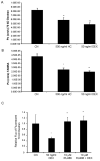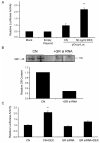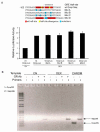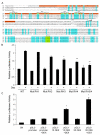Glucocorticoids induce transactivation of tight junction genes occludin and claudin-5 in retinal endothelial cells via a novel cis-element
- PMID: 18501346
- PMCID: PMC2613867
- DOI: 10.1016/j.exer.2008.01.002
Glucocorticoids induce transactivation of tight junction genes occludin and claudin-5 in retinal endothelial cells via a novel cis-element
Abstract
Tight junctions between vascular endothelial cells help to create the blood-brain and blood-retinal barriers. Breakdown of the retinal tight junction complex is problematic in several disease states including diabetic retinopathy. Glucocorticoids can restore and/or preserve the endothelial barrier to paracellular permeability, although the mechanism remains unclear. We show that glucocorticoid treatment of primary retinal endothelial cells increases content of the tight junction proteins occludin and claudin-5, co-incident with an increase in barrier properties of endothelial monolayers. The glucocorticoid receptor antagonist RU486 reverses both the glucocorticoid-stimulated increase in occludin content and the increase in barrier properties. Transcriptional activity from the human occludin and claudin-5 promoters increases in retinal endothelial cells upon glucocorticoid treatment, and is dependent on the glucocorticoid receptor (GR) as demonstrated by siRNA. Deletion analysis of the occludin promoter reveals a 205bp sequence responsible for the glucocorticoid response. However, this region does not possess a canonical glucocorticoid response element and does not bind to the GR in a chromatin immunoprecipitation (ChIP) assay. Mutational analysis of this region revealed a novel 40bp occludin enhancer element (OEE), containing two highly conserved regions of 10 and 13 base pairs, that is both necessary and sufficient for glucocorticoid-induced gene expression in retinal endothelial cells. These data suggest a novel mechanism for glucocorticoid induction of vascular endothelial barrier properties through increased occludin and claudin-5 gene expression.
Figures







References
-
- Aiello LP, Gardner TW, King GL, Blankenship G, Cavallerano JD, Ferris FL, 3rd, Klein R. Diabetic retinopathy. Diabetes Care. 1998;21:143–56. - PubMed
-
- Aijaz S, Balda MS, Matter K. Tight junctions: molecular architecture and function. Int Rev Cytol. 2006;248:261–98. - PubMed
-
- Antonetti DA, Barber AJ, Khin S, Lieth E, Tarbell JM, Gardner TW. Vascular permeability in experimental diabetes is associated with reduced endothelial occludin content: vascular endothelial growth factor decreases occludin in retinal endothelial cells. Penn State Retina Research Group. Diabetes. 1998;47:1953–9. - PubMed
-
- Antonetti DA, Wolpert EB. Isolation and characterization of retinal endothelial cells. Methods Mol Med. 2003;89:365–74. - PubMed
Publication types
MeSH terms
Substances
Grants and funding
LinkOut - more resources
Full Text Sources
Other Literature Sources
Medical
Miscellaneous

